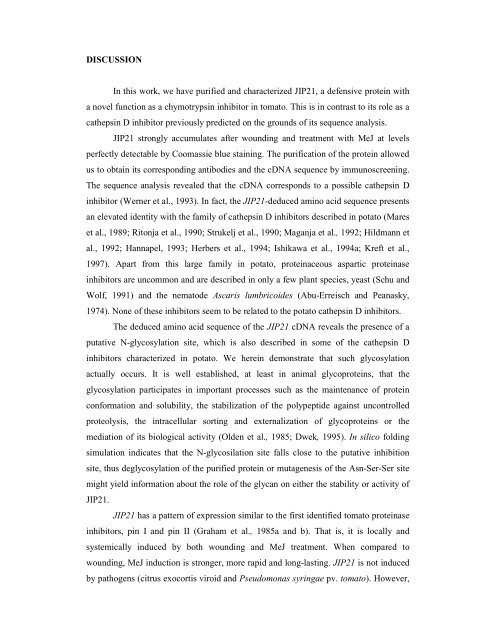Tomato CDI as a Strong Chymotrypsin Inhibitor ... - Plant Physiology
Tomato CDI as a Strong Chymotrypsin Inhibitor ... - Plant Physiology
Tomato CDI as a Strong Chymotrypsin Inhibitor ... - Plant Physiology
Create successful ePaper yourself
Turn your PDF publications into a flip-book with our unique Google optimized e-Paper software.
DISCUSSION<br />
In this work, we have purified and characterized JIP21, a defensive protein with<br />
a novel function <strong>as</strong> a chymotrypsin inhibitor in tomato. This is in contr<strong>as</strong>t to its role <strong>as</strong> a<br />
cathepsin D inhibitor previously predicted on the grounds of its sequence analysis.<br />
JIP21 strongly accumulates after wounding and treatment with MeJ at levels<br />
perfectly detectable by Coom<strong>as</strong>sie blue staining. The purification of the protein allowed<br />
us to obtain its corresponding antibodies and the cDNA sequence by immunoscreening.<br />
The sequence analysis revealed that the cDNA corresponds to a possible cathepsin D<br />
inhibitor (Werner et al., 1993). In fact, the JIP21-deduced amino acid sequence presents<br />
an elevated identity with the family of cathepsin D inhibitors described in potato (Mares<br />
et al., 1989; Ritonja et al., 1990; Strukelj et al., 1990; Maganja et al., 1992; Hildmann et<br />
al., 1992; Hannapel, 1993; Herbers et al., 1994; Ishikawa et al., 1994a; Kreft et al.,<br />
1997). Apart from this large family in potato, proteinaceous <strong>as</strong>partic protein<strong>as</strong>e<br />
inhibitors are uncommon and are described in only a few plant species, ye<strong>as</strong>t (Schu and<br />
Wolf, 1991) and the nematode Ascaris lumbricoides (Abu-Erreisch and Pean<strong>as</strong>ky,<br />
1974). None of these inhibitors seem to be related to the potato cathepsin D inhibitors.<br />
The deduced amino acid sequence of the JIP21 cDNA reveals the presence of a<br />
putative N-glycosylation site, which is also described in some of the cathepsin D<br />
inhibitors characterized in potato. We herein demonstrate that such glycosylation<br />
actually occurs. It is well established, at le<strong>as</strong>t in animal glycoproteins, that the<br />
glycosylation participates in important processes such <strong>as</strong> the maintenance of protein<br />
conformation and solubility, the stabilization of the polypeptide against uncontrolled<br />
proteolysis, the intracellular sorting and externalization of glycoproteins or the<br />
mediation of its biological activity (Olden et al., 1985; Dwek, 1995). In silico folding<br />
simulation indicates that the N-glycosilation site falls close to the putative inhibition<br />
site, thus deglycosylation of the purified protein or mutagenesis of the Asn-Ser-Ser site<br />
might yield information about the role of the glycan on either the stability or activity of<br />
JIP21.<br />
JIP21 h<strong>as</strong> a pattern of expression similar to the first identified tomato protein<strong>as</strong>e<br />
inhibitors, pin I and pin II (Graham et al., 1985a and b). That is, it is locally and<br />
systemically induced by both wounding and MeJ treatment. When compared to<br />
wounding, MeJ induction is stronger, more rapid and long-l<strong>as</strong>ting. JIP21 is not induced<br />
by pathogens (citrus exocortis viroid and Pseudomon<strong>as</strong> syringae pv. tomato). However,

















